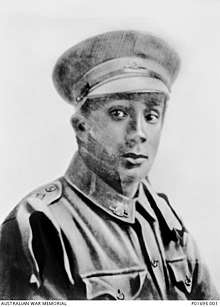William Reginald Rawlings
William Reginald Rawlings, MM (September 1890 – 9 August 1918) was a decorated Australian Aboriginal soldier of the First World War. He was also the uncle of Captain Reginald Saunders, the first Aboriginal commissioned officer in the Australian Military Forces.
William Reginald Rawlings | |
|---|---|
 | |
| Born | September 1890 Purnim, Australia |
| Died | 9 August 1918 (aged 27) Vauvillers, France |
| Buried | |
| Allegiance | Australia |
| Service/ | Australian Imperial Force |
| Years of service | 1916–1918 |
| Rank | Private |
| Unit | 29th Battalion |
| Battles/wars | First World War |
| Awards | Military Medal |
Early life
Rawlings was born in Purnim, Victoria, in September 1890 to William and Bessie Rawlings.[1] He grew up on the Aboriginal reserve at Framlingham, and was a horse-breaker around Purnim before enlisting in the Australian Imperial Force at Warrnambool, Victoria on 20 March 1916.[2]
First World War
After undertaking initial training, Rawlings embarked on HMAT Orsova from Melbourne on 1 August 1916.[1] He joined the 29th Battalion, 8th Brigade in France, as part of the battalion's 8th Reinforcements.[3]
Rawlings was awarded the Military Medal for bravery during heavy fighting along the Morlancourt Ridge on the 28–29 July 1918. Private Rawlings was killed in action on 9 August 1918, during the capture of Vauvillers, France. Rawlings was 27 years old.[1] His MM was gazetted on 11 December 1918.[4]
Rawlings' friend, Henry Thorpe, who also received the Military Medal, was killed on the same day. They are both buried in the Heath Cemetery, Harbonnieres, France.[5][6]
Notes
- "William Reginald Rawlings". Australian Defence Force Academy. Retrieved 20 November 2010.
- Austin 1997, pp. 135–136.
- Austin 1997, p. 136.
- "No. 31061". The London Gazette (Supplement). 10 December 1918. p. 14669.
- "Casualty Details: Rawlings, William Reginald". Commonwealth War Graves Commission. Retrieved 30 July 2012.
- "Casualty Details: Thorpe, Harry". Commonwealth War Graves Commission. Retrieved 30 July 2012.
References
- Austin, Ron (1997). Black and Gold: The History of the 29th Battalion, 1915–1918. McCrae: Slouch Hat Publications. ISBN 0-646-31650-8.
External links
- Digital images of NAA: B2455, Rawlings William Reginald, First World War personnel file, National Archives of Australia